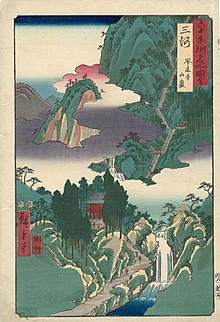Mikawa Province

Mikawa Province (三河国, Mikawa no kuni) was an old province in the area that today forms the eastern half of Aichi Prefecture.[1] Its abbreviated form name was Sanshū (三州 or 参州). Mikawa bordered on Owari, Mino, Shinano, and Tōtōmi Provinces.

Mikawa is classified as one of the provinces of the Tōkaidō. Under the Engishiki classification system, Mikawa was ranked as a "superior country" (上国) and a "near country" (近国) in terms of its distance from the capital.
History
Mikawa is mentioned in records of the Taika Reform dated 645, as well as various Nara period chronicles, including the Kujiki, although the area has been settled since at least the Japanese Paleolithic period, as evidenced by numerous remains found by archaeologists. Early records mention a "Nishi-Mikawa no kuni" and a "Higashi-Mikawa no kuni", also known as Ho Province (穂国, Ho no kuni). Although considered one administrative unit under the Engishiki classification system, this division (roughly based at the Yasaku River) persisted informally into the Edo period.
The exact location of the provincial capital is not known. Traditionally considered to have been located in the Ko-machi (国府町) area of the modern city of
During the
The various domains and tenryō territories were transformed into short-lived prefectures in July 1871 by the
After World War II, the territory of former Mikawa Province prospers as the capital of the Japanese automobile industry.
Historical districts
Mikawa Province consisted of nine districts:
- Aichi Prefecture
- Atsumi District(渥美郡) – dissolved
- Hazu District(幡豆郡) – dissolved
- Hekikai District(碧海郡) – dissolved
- Hoi District(宝飯郡) – dissolved
- Kamo District (加茂郡)
- Higashikamo District(東加茂郡) – dissolved
- Nishikamo District(西加茂郡) – dissolved
- Nukata District(額田郡)
- Shitara District (設楽郡)
- Kitashitara District(北設楽郡)
- Minamishitara District(南設楽郡) – dissolved
Domains in Mikawa Province
| Domain | Daimyō | Dates | Revenue (koku) | Type |
|---|---|---|---|---|
| Koromo Domain (挙母藩) | Naitō | 1604–1871 | 20,000 | fudai |
| Yoshida Domain (吉田藩) | Matsudaira (Nagasawa-Ōkōchi) | 1600–1693 | 70,000 | fudai |
| Tahara Domain (田原藩) | Miyake | 1601–1871 | 12,000 | fudai |
| Okazaki Domain (岡崎藩) | Honda | 1601–1871 | 50,000 | fudai |
| Nishio Domain (西尾藩) | Ogyū-Matsudaira clan | 1638–1827 | 60,000 | fudai |
| Kariya Domain (刈屋藩) | Doi | 1600–1868 | 23,000 | fudai |
| Nishi-Ōhira Domain (西大平藩) | Ōoka | 1748–1871 | 10,000 | fudai |
| Okutono Domain (奥殿藩) | Ogyū-Matsudaira clan | 1664–1871 | 16,000 | fudai |
| Hatagamura Domain (畑ヶ村藩) | Toda clan (subsidiary of Ōgaki Domain) | 1688–1871 | 10,000 | fudai |
Sports
References
Citations
- .
Sources
- Papinot, Edmond. (1910). Historical and Geographic Dictionary of Japan. Tokyo: Librarie Sansaisha. OCLC 77691250
